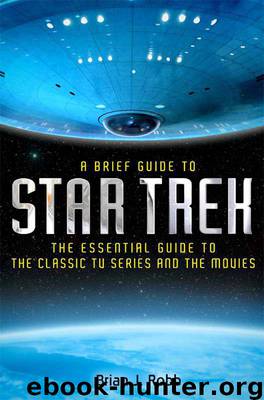A Brief Guide to Star Trek by Brian J Robb

Author:Brian J Robb [Robb, Brian J]
Language: eng
Format: epub
Published: 2013-09-22T16:00:00+00:00
The command crew characters of The Next Generation were closer to Gene Roddenberry’s original ideas for the 1960s series, which had been seriously derailed by the popularity of Spock and the dominance of the Kirk–Spock–McCoy triumvirate. However, the characters on the bridge of the Enterprise continued to be split down the traditional Star Trek opposition of science versus emotion. In Picard there is something of the Vulcan in his unemotional aloofness that often sets him apart from the rest of the crew. With Riker filling the womanising action-hero role previously filled by Kirk (all emotion), The Next Generation allows the captain to step back from the immediate crisis and have a broader overview. When Picard meets Spock in the 1991 episode ‘Unification II’, Spock sees much of his Vulcan father in the human captain of the Enterprise (Sarek and Picard shared that most intimate of connections, the Vulcan mind-meld). It is only through mind-melding with Picard that Spock finally understands his father’s true feelings for his half-human, half-Vulcan son.
Picard leads the non-emotional grouping of characters: those who look to ideas and pragmatic solutions rather than acting on instinct. Among this group are Data (searching for a way to experience emotions that Spock suppresses, Data discusses their opposite views of humanity in ‘Unification II’); the Crusher family, consisting of Dr Beverly Crusher (who returned to the show in the third season, also a long-term romantic interest for Picard), youthful prodigy Wesley Crusher (although Picard initially dislikes having children on board his ship) and Chief Engineer Geordi La Forge.
Riker heads up the emotional group, those who might leap before looking, whose actions are driven by instinct and feelings. Among this latter group are (of course) the ship’s telepathic half-Betazoid counsellor Deanna Troi, and security chief Worf (whose Klingon aggression is a problem to be overcome, as was Spock’s half-humanity in the original series).
The Next Generation took a more sophisticated view of encounters with other species than the original series managed. In many episodes, the Enterprise appears to be the space equivalent of the United Nations, negotiating disputes or mediating between alien species in search of conflict resolution. This was a very 1990s obsession (following perestroika in Russia, the fall of the Berlin Wall in 1989 and the end of the Cold War), and departs from the cliché of 1960s Star Trek in which Kirk was thought to shoot his phaser first and ask questions later. This approach to storytelling was even reflected in the design aesthetic of the new Enterprise, which appeared to be an inter-galactic conference centre, with its colour schemes, décor and design all reminiscent of a public building or international chain hotel.
Whereas Kirk emphasised human values as correct above all else, Picard and co were more respectful of life (or consciousness), whatever form it might take. A story like ‘The Devil in the Dark’ from The Original Series – in which a ‘monster’ threatening miners is found to simply be a mother protecting its young – would not be
Download
This site does not store any files on its server. We only index and link to content provided by other sites. Please contact the content providers to delete copyright contents if any and email us, we'll remove relevant links or contents immediately.
| Direction & Production | Genres |
| Guides & Reviews | History & Criticism |
| Reference | Screenwriting |
| Shows |
Robin by Dave Itzkoff(2411)
Head of Drama by Sydney Newman(2274)
I'm Judging You by Luvvie Ajayi(2177)
The Paranormal 13 (13 free books featuring witches, vampires, werewolves, mermaids, psychics, Loki, time travel and more!) by unknow(2070)
Ten by Gretchen McNeil(1855)
Single State of Mind by Andi Dorfman(1791)
#MurderTrending by Gretchen McNeil(1637)
Key to the Sacred Pattern: The Untold Story of Rennes-le-Chateau by Henry Lincoln(1613)
Merv by Merv Griffin(1599)
Most Talkative by Andy Cohen(1570)
This Is Just My Face by Gabourey Sidibe(1451)
Notes from the Upside Down by Guy Adams(1447)
The Hunger Games: Official Illustrated Movie Companion by Egan Kate(1411)
Springfield Confidential by Mike Reiss(1391)
Binging with Babish by Andrew Rea(1377)
Jamie Oliver by Stafford Hildred(1374)
The TV Writer's Workbook: A Creative Approach To Television Scripts by Ellen Sandler(1328)
Clarkson--Look Who's Back by Gwen Russell(1325)
Blue Planet II by James Honeyborne & Mark Brownlow(1259)
